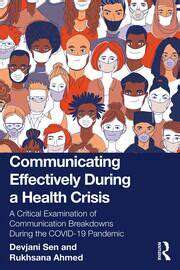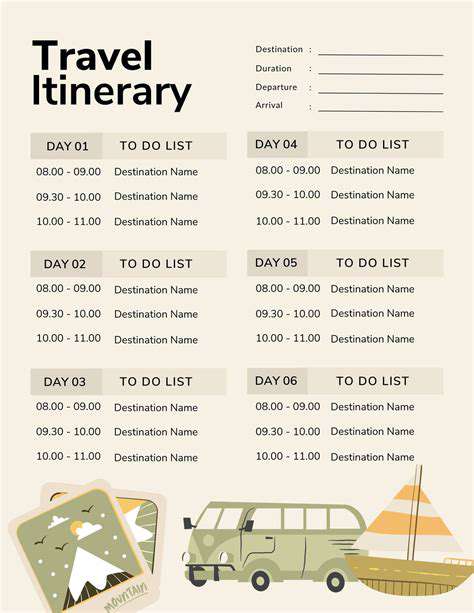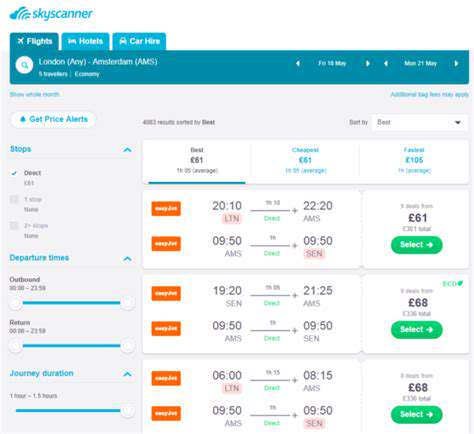How to Handle Travel Emergencies
Understanding the Potential for Lost Luggage
Few travel experiences are as frustrating as arriving at your destination only to discover your luggage didn't make the journey with you. This common travel mishap can turn a dream vacation into a logistical nightmare. Airlines report that approximately 5-7 bags per 1,000 passengers experience some form of mishandling annually, making this a statistically significant concern for travelers.
Smart travelers know that prevention begins before you even pack your suitcase. Consider using brightly colored luggage that stands out on baggage carousels, or better yet, invest in luggage with built-in GPS tracking. Many frequent flyers swear by the 2-1-1 packing method: two sets of clothes in checked baggage, one in carry-on, and one on your person (like a jacket or sweater). This layered approach ensures you're never left completely without essentials.
Contacting the Airline or Transportation Provider
When your luggage fails to appear on the carousel, immediately locate the airline's baggage service office - typically found near the baggage claim area. Bring your boarding pass, baggage claim tickets, and photo ID. Most airlines have a 4-24 hour window for reporting lost luggage before claims become more complicated.
Modern airlines use sophisticated tracking systems like WorldTracer, which can often locate missing bags within hours. Insist on getting a Property Irregularity Report (PIR) number - this unique reference code becomes your lifeline for tracking progress. Many carriers now offer mobile apps where you can monitor your claim status in real-time.
Filing a Claim and Understanding Your Rights
International air travel operates under the Montreal Convention, which currently sets maximum liability at about €1,300 (~$1,400) per bag. However, most U.S. domestic flights operate under different rules, typically capping liability at $3,800. These amounts represent maximums, not guarantees - airlines will often depreciate item values.
For valuable items, consider declaring them at check-in (usually for an additional fee) or better yet, carry them with you. Many travelers don't realize that standard travel insurance often provides better coverage than airline liability limits, especially for high-value items like cameras or jewelry.
Gathering Essential Documentation
Create a luggage emergency kit before you travel that includes:- Photos of your packed luggage (inside and out)- Receipts for expensive items- Copies of your itinerary and passport- A list of serial numbers for electronics
This documentation becomes invaluable when filing claims. Some savvy travelers even pack a printed inventory sheet inside their suitcase to help identify contents if tags are lost.
Alternatives for Essential Items
The golden rule of travel packing: never check anything you can't afford to lose for 72 hours. Your carry-on should contain:- Medications (in original containers)- One change of clothes- Basic toiletries- Chargers and essential electronics- Copies of important documents
Many airports now have luggage emergency stores that sell basic necessities, and some hotels offer complimentary toiletries for guests in this situation. If you're staying at a resort, check if they provide loaner clothing or swimwear.
Seeking Assistance from Travel Agencies or Services
For complex international cases, consider services like AirHelp or Compensair that specialize in travel disruption claims. These services typically work on contingency, taking a percentage of any compensation they recover for you.
Frequent travelers might explore premium luggage protection services like Luggage Forward or specialized insurance through providers like Allianz Travel that offer baggage delay coverage starting just a few hours after loss.
Navigating Medical Emergencies Abroad
Understanding Potential Risks
Travel medicine specialists identify three main categories of health risks abroad: environmental (altitude, pollution), biological (diseases), and situational (accident risks). Your risk profile changes dramatically depending on whether you're visiting a metropolitan area versus remote wilderness.
The CDC's Travelers' Health website offers destination-specific recommendations that are updated in real-time. For example, did you know that traffic accidents represent the 1 cause of preventable death for international travelers? This surprising statistic highlights why understanding non-disease risks is equally important as vaccination planning.
Preparing for Emergencies
Create a medical emergency card that includes:- Blood type- Allergies- Current medications- Emergency contacts- Insurance information
Store this information both digitally (in your phone's emergency access features) and physically (in your wallet). Many hospitals abroad can provide better care when they have this basic information immediately available.
Accessing Healthcare Abroad
International hospitals accredited by the Joint Commission International (JCI) meet rigorous standards comparable to U.S. hospitals. Websites like the International Society of Travel Medicine maintain directories of quality healthcare providers worldwide.
In many countries, pharmacists can diagnose and prescribe for minor ailments - often at lower cost and greater convenience than visiting a clinic. Know the local equivalent of 911; in Europe it's 112, while Japan uses 119 for medical emergencies.
Utilizing Travel Insurance
Standard health insurance rarely covers international care adequately. Look for policies with:- $50,000+ medical coverage- $250,000+ medical evacuation- Direct payment to providers (not reimbursement)- 24/7 assistance services
Specialized providers like GeoBlue or IMG offer comprehensive expatriate coverage if you'll be abroad long-term. Cruise lines and tour operators often sell supplemental policies specifically designed for their itineraries.
Communicating Effectively
Download medical translation apps like MediBabble or Canopy that work offline. These provide symptom-specific translations in dozens of languages. Consider carrying a pictorial medical dictionary - images transcend language barriers when describing pain locations or symptoms.
For chronic conditions, wear a medical alert bracelet with information in both English and the local language. The International Association for Medical Assistance to Travelers (IAMAT) offers translated medical phrases for free to members.
Seeking Professional Guidance
Schedule a travel medicine consultation 4-6 weeks before departure. Specialists can provide:- Destination-specific vaccines (like Japanese Encephalitis for rural Asia)- Malaria prophylaxis recommendations- Altitude sickness prevention strategies- Specialized advice for pregnant travelers or those with chronic conditions
Many university medical centers now offer travel clinics with physicians certified in travel medicine. These specialists stay current on global health threats and can provide yellow fever vaccinations and other travel-specific immunizations.
Dealing with Flight Cancellations and Delays

Understanding the Reasons for Cancellations
Flight disruptions generally fall into three categories:1. Controllable (crew scheduling, maintenance)2. Semi-controllable (air traffic control)3. Uncontrollable (weather, security)
The U.S. Department of Transportation requires airlines to disclose the true reasons for cancellations, which you can often find in their monthly operational reports. Interesting fact: thunderstorms account for nearly 75% of all weather-related delays, with winter weather causing longer but fewer disruptions overall.
Airline Policies and Procedures
U.S. airlines are not legally required to provide compensation for cancellations within their control, though many offer:- Meal vouchers for delays over 3 hours- Hotel accommodations for overnight delays- Rebooking on partner airlines
The EU's EC261 regulation provides stronger protections, mandating cash compensation up to €600 for eligible cancellations. Smart travelers always check both the operating airline's policy and the relevant aviation authority's regulations.
Passenger Rights and Responsibilities
When facing cancellations:1. Document everything (take screenshots of departure boards)2. Get written confirmation of rebooking3. Save all receipts for unexpected expenses4. Know that you're entitled to a full refund if cancellation causes you to abandon your trip
Many credit cards offer automatic travel delay protection if you booked with them, typically covering meals and lodging after 6-12 hour delays. Check your card's benefits guide before paying out of pocket.
Rescheduling and Alternatives
During mass cancellations:- Avoid calling overwhelmed airline phone lines- Use airport kiosks for self-service rebooking- Check alternate airports within driving distance- Consider hidden city ticketing (with caution)
Apps like FlightAware or FlightRadar24 show real-time aircraft locations, helping you determine if your plane is actually coming. Some airlines now offer automatic rebooking via text message during disruptions.
Communicating Effectively During Crises

Effective Communication Strategies
The PEACE model works well in crisis communication:P - Prepare key messages in advanceE - Express empathyA - Answer questions transparentlyC - Commit to ongoing updatesE - Evaluate and adjust communication
During emergencies, people typically remember only 3-5 key points, so prioritize the most critical information. The CDC's CERC (Crisis and Emergency Risk Communication) framework recommends leading with what people need to do, followed by why they should do it.
Understanding Your Audience
Cultural differences dramatically affect crisis communication:- High-context cultures (Japan, Arab countries) prefer implicit messages- Low-context cultures (U.S., Germany) want explicit instructions- Collectivist societies respond better to group-focused messaging- Individualist cultures want personalized information
Religious and social norms may dictate appropriate communication channels - in some conservative societies, female travelers may need female interpreters for medical communications.
Active Listening and Feedback
Implement the LOOP technique:L - Listen without interruptingO - Organize the key concernsO - Offer solutionsP - Paraphrase to confirm understanding
In high-stress situations, people often need to vent before they can process information. Allowing this emotional release (while maintaining boundaries) builds trust more effectively than immediate problem-solving.
Transparency and Honesty
The Rule of Three enhances message retention:1. Tell them what you're going to tell them2. Tell them3. Tell them what you told them
When information is uncertain, it's better to say we're working to verify that than to speculate. Studies show that transparent communication during crises actually improves organizational reputation long-term, even when the news is bad.
Building Trust and Collaboration
Establish credibility early by:- Introducing your qualifications briefly- Acknowledging what you don't know- Showing consistency with previous communicators- Demonstrating empathy through body language
In multicultural settings, pay attention to non-verbal communication norms. For example, maintaining eye contact builds trust in Western cultures but may be considered aggressive in some Asian contexts.

![Planning a Family Camping Trip [Beginner's Guide]](/static/images/27/2025-04/MakingtheMostofYourCampingExperience.jpg)









